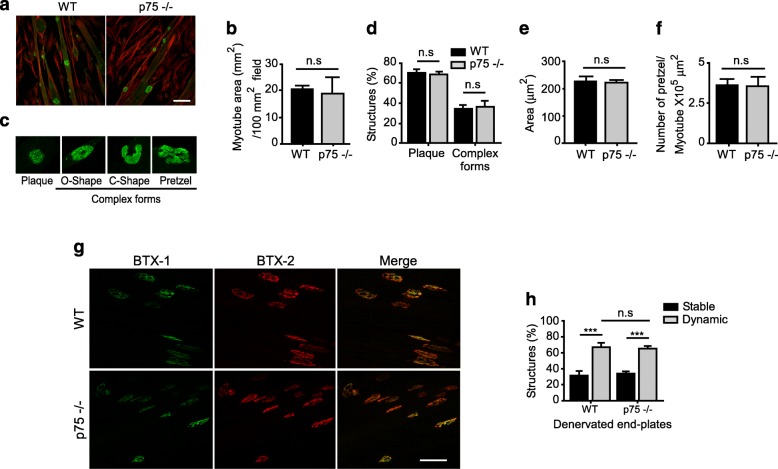Fig. 5.
Muscle-derived p75NTR is not required for nerve-independent AChR aggregation. Myoblasts from the gastrocnemius muscle of 2–4 months old WT and p75NTR−/− mice were induced to fuse into myotubes for 5 days onto poly-ornithine/laminin coated dishes. a Representative laser confocal images show myotubes from both genotypes stained to reveal actin (phalloidin, red) and AChR aggregates (BTX, green) Scale bar: 50 μm. b Quantification of myotube area per field show no differences amongst both genotypes. c Morphology of aneurally-induced complex AChR aggregates, which were classified into “plaques” and “complex shapes”, the latter including O-, C-, and pretzel-like shapes. d The relative abundance of AChR shapes was quantified and expressed as a fraction of the total AChR structures. e The area of AChR shapes was also determined. f Quantification of the number of AChR shapes expressed regarding the myotube area. The plots represent the mean ± SEM of n = 4 (WT and p75NTR−/−) mice. Three cultures for each animal and 30–50 AChR aggregates were analyzed per experiment. g–h For the in vivo two-color BTX method, LAL muscles from WT and p75NTR−/− mice were labeled with BTX-1 and the right hemi-LAL muscle was subsequently denervated by facial nerve transection. After a 7-day recovery period, LAL muscles were dissected and labeled with BTX-2. NMJs in maximum intensity projection images of LAL whole mounts (g; Bar: 50 μm) were categorized in “stable” or “dynamic” according to both BTX relative intensities, and quantified (h). n.s., non-significant, ***p < 0.01, unpaired t-test (b, e, f), or two-way ANOVA (d, h)

